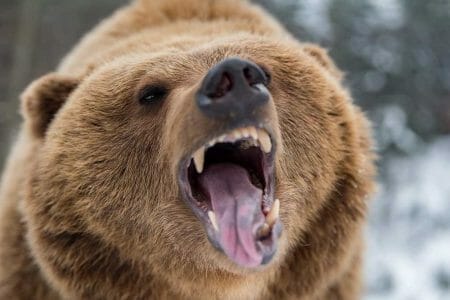
The late, great wildlife biologist and expert on animal behavior, Valerius Geist, noted the tremendous benefit that hunters create for other people who use wild country. He calls it “freedom of the woods”. A short version is included in this Wolf Essay.
There is a great Public Good that hunters give to society at large, which I may call here the “freedom of the woods.” It is based on the fact that an armed person acts quite differently from an unarmed one when meeting predators, and we have reason to believe that the predators notice the difference via sight, sound and smell. A confident person is quite intimidating to carnivores, while a fearful one merely encourages predators to confront people. Therefore, unarmed people in the backcountry encourage misbehaviour in predators to the detriment of predators.
Secondly, and of great importance, is that inefficient hunting of predators conditions the animals negatively so that they avoid humans. Subsequently, hikers, campers, and picnickers can go into the woods in safety as carnivores stay away from humans. The Achilles heel of carnivores is being stalked systematically, just as they prey on smaller or weaker members of their own species. Carnivores are cannibalistic; and grizzly bears and wolves are no exception. Consequently, being stalked is very likely a terrifying experience to bears or wolves. Hunted carnivores negatively conditioned will coexist splendidly with humans. That’s the big lesson from our history where we lived together with carnivores in North America (or in Siberia). Where large carnivores are de facto protected, where they may multiply unimpeded, livestock, pets and eventually humans become their victims—let alone game animals.
Dr. Geist explained the concept in great detail in his paper: Habituation, Taming, Social Dominance Assertions, and “Freedom of the Woods”. Armed humans in the woods essentially teach predators to be wary of humans. Once this caution is established, even unarmed humans are safe from nearly all predators in the woods.
Some of the new worshipers of nature state that one of the primary reasons they want bears to be protected is because they want to experience areas where humans are not at the top of the food chain. They are not referring to the highly technical definition of “food chain” that theoretical biologists have contrived. They are considering which animals are afraid of which other animals.
“Top of the food chain” is a shortcut for who is dominant. Some neo-pagans wish to visit areas where people are not dominant. Another way to consider this is to see it as a desire to reduce human power below that of top predators.
Since the invention of effective weapons, most particularly cartridge firearms, humans have dominated every other species on land. It is only when humans are disarmed or otherwise restrained by their own species that land predators do not learn to be wary of humans.
Dr. Geist’s essential point is that apex predators such as bears, wolves, and mountain lions learn to fear and respect humans when humans act as the top predator because they are armed.
His contention is that apex predators are intensely aware of how other animals act in the woods/wilderness. Humans which act as an apex predator act confidently and unafraid. This is why people are advised to stand their ground, to not run, to not climb a tree as a means to escape. Running or climbing a tree, in effect, signals to the predator the human is below it in dominance. These actions signal that the human is not dangerous.
If enough humans wander about the woods armed, acting as if they have little to fear from other denizens of the environment, apex predators learn to reflexively avoid humans. This is the effect Dr. Geist observed directly in his studies. This is how the myth of the “harmless wolf” was created in North America.
Assumed in Dr. Geist’s thesis is the understanding of apex predators as inherently dangerous to humans. To project confidence as the top apex predator, humans need to be able to protect themselves from other predators. Being armed with a firearm that can be used in effective defense against large animals results in the necessary confidence.
Regulations and legislation that prohibit humans from being armed in national parks are counterproductive. They were initially created to protect the animals in the parks. Carrying arms for self-defense is not the same as hunting or poaching.
The small number of predators that are killed in self-defense situations eliminates a few excessively aggressive predators, with no significant effect on predator populations. The death of those predators amplifies the perception of humans as dangerous in the remaining predator population. Other predators don’t have to witness the actual event. Scent on the scene is like a bill board of what happened to other predators.
When you are in wild areas, go armed. Virtually any handgun will give you more confidence than hiking with bear spray. Use a good holster and practice. This will improve your confidence, and aids in the ancillary use as protection against aggressive humans. Your actions translate to higher levels of safety for those who choose to be unarmed.
Your actions help to create the “freedom of the woods”.
About Dean Weingarten:
Dean Weingarten has been a peace officer, a military officer, was on the University of Wisconsin Pistol Team for four years, and was first certified to teach firearms safety in 1973. He taught the Arizona concealed carry course for fifteen years until the goal of Constitutional Carry was attained. He has degrees in meteorology and mining engineering, and retired from the Department of Defense after a 30 year career in Army Research, Development, Testing, and Evaluation.</p>







Freedom of the Streets!
I walk in the woods daily. I am armed on every walk. I have seen and confronted Black bears and wolves many times. Being armed has enabled me to back the bears and wolves down. Thus teaching them to m be wary of humans. Bears are hunted hard in my area. They do not stick around when confronted by a human. Wolves are on the other hand are heavily protected . They tend to stick around a bit longer but so far they do flee. Coyotes and bobcats run right now. They are also hunted hard. Hunting animals make the… Read more »
Thanks Dean, great article. I kept saying to myself Right On! As I progressed through the body of your work.
armed in woods in town, worst predictors are in the shitties
Interesting perspective! I believe it has merit.
Dean, this is one your best yet. I’ve long believed that I hunters a debt for being able to simply walk around in the woods. The wolf essay you link to is also interesting, and I’ll be reading that one in detail as well. Great stuff. I appreciated your reference to neo-pagans. I am familiar with Paul’s words in Romans 1 about people worshiping the created rather than the creator, which leads naturally to worshipping the earth and valuing the lives of predator animals over and above human life. That I believe is at root of the pro-predator sentiment that… Read more »
I agree with the piece’s position. I hiked in Rocky Mountain National Park last Saturday, with my carry pistol. It’s a challenge, when you’re trying to pack light, but I see it as essential survival equipment in predator country. I applaud the National Park Service’s current policy of allowing carry, but they need to allow it in their buildings, also. Right now, you can’t legally carry in park restrooms or welcome centers. Bad news if your car is 20 miles away. I will say that I still occasionally encounter an apex predator in the wild that doesn’t show much fear… Read more »
this is the same logic as…we had to destroy that village in order to save it